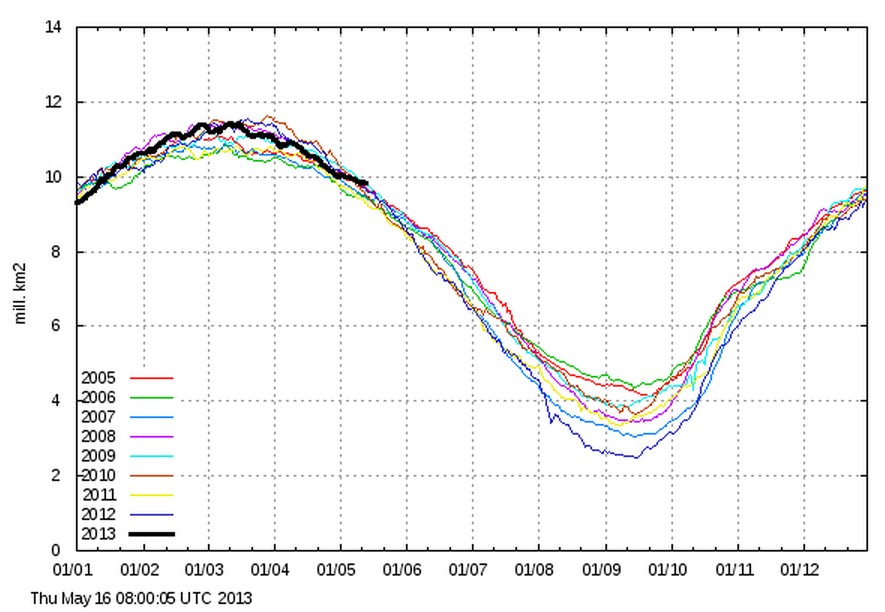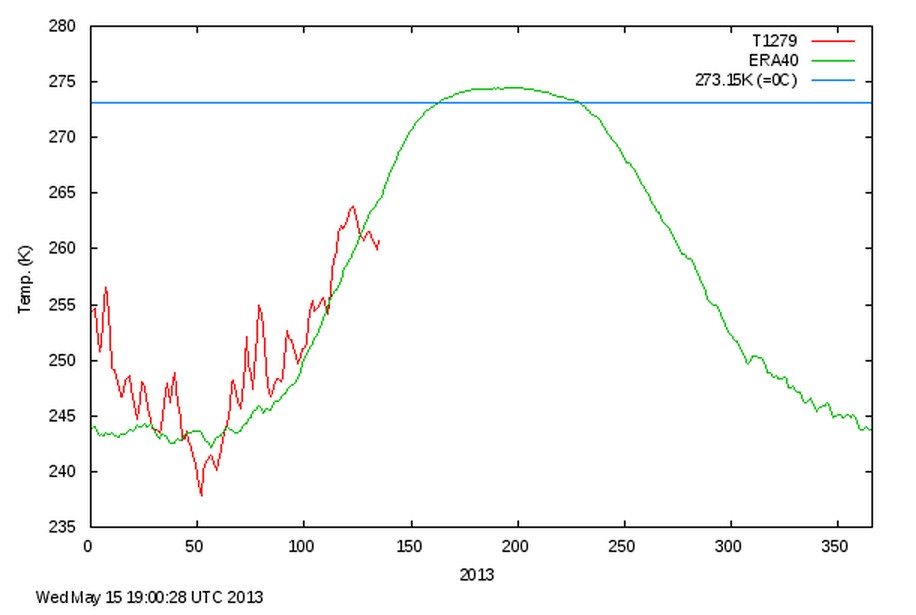Arctic sea ice is melting very slowly, and ice extent is the highest for the date since 2002.
COI | Centre for Ocean and Ice | Danmarks Meteorologiske Institut
The slow melt is not surprising, because temperatures in the Arctic are almost 5C below normal.
COI | Centre for Ocean and Ice | Danmarks Meteorologiske Institut




Obama has healed the Arctic Ocean…!!
See what AGW can do – cool the arctic!
I should have said, ” See what Saint Obama and AGW can do – cool the arctic!
Couple or 3 of points
1. Spring or autumn melt is not really a good indicator of things compared to summer and winter max.
2, Winter max in Arctic is still tied to geography.
3. Last year at this time you were saying that the average sea ice had it the NSIDC average since 1979 as if it was some big thing. After that we got the biggest melt on record of course.
4. Your comments from people like Lance or terrance indicate you have people commentating on your blog who know little about the arctic nowadays and are “political”
If they have nothing to say then they should shut up. I know I cast the other point but at least I have been watching the Arctic for a few years, these guys seem just like “Yes” men
Andy
I suggest you take a hike across Greenland, then report back on Arctic warming.
RE: Andy – “these guys seem just like “Yes” men ”
It seems lately that everyone is someone’s “Yes” man, right Andy?
I am glad both you and terrence have the right to speak at Steven’s blog
At the moment, the extent in 2013 is about the same as in 2012 at this time of year. Given that 2012 set a new record low it is apparent that the extent in May is not a good predictor for the September minimum. Given the distribution of ice age in the Arctic, if the same sort of melt/transport as observed last summer occurred again this summer, a new record low will be reached. I think that is unlikely, unless the ice is thinner this year than last. Will be good to see CryoSat ice thickness fields from this year.
RE: Julienne Stroeve – “if the same sort of melt/transport”
Isn’t it more than melt and transport?
The extended August cyclone played a large part in the breakup of the icepack. Look at the videos. Crushed ice melts faster than one large cube.
Since you mentioned transport, has the NSIDC finished the estimate of the total volume of multiyear ice exported out of the Fram Strait since 1988? I would be interested in how many cu km of ice were lost due to transport.
Based on your explanation Julienne, the winter storm last August must have removed a lot of heat from the Arctic Ocean. That combined with the cold air temperatures and highly concentrated ice this year don’t bode well for alarmists.
For those that are new to this ( and what shills like Julienne will not tell you ) is that they are using 15% sea-ice as the threshold cutoff for “ice-free”. It doesn’t take a rocket scientist to figure out that sea-ice concentration at say 20% could be knocked around by the wind ( see Minnesota recently for a demonstration ) and depending upon countless variables could become packed more tightly or on the other hand spread out further to fall below the 15% threshold, thereby instantly becoming “ice-free” when in fact those waters would be exceptionally icy and dangerous to traverse. In fact, imagine a hypothetical season with no melting whatsoever and the wind alone could change the total alleged sea-ice concentration from high to low and vice versa.
So the sea-ice extent game is completely about the configuration of the ice from strong, chaotic variables like the wind and currents. The right combination of variables results in a wide range of possible outcomes that overwhelms C02. The exact same mass of ice can be re-configured in a myriad of ways to result in almost any numerical result at the end of the season.
This is a sucker’s game. The entire AGW hoax is geared around the alleged magic number of sea-ice minimum for a few days at the end of the melt season each year. Nothing could be of less consequence whatsoever. Yet right on cue, here they come setting the stage for the next season propaganda fest.
Andy: point 3: that was not a melt. The ice was dispersed by a big storm. And, sea ice levels not only have since, within a year, recovered to the norm of the most recent years, they have surpassed that and are at 20-yr norms.
Yes, it is not very good to look at daily levels in these spring and fall transitions, since the slopes are variable but always steep. That is good advice – for people impressed by last fall’s “melt.”
Andy: Why do you not analyze the information that Is being presented by Steven and cut the BS. That would not be of any interest to you and your kind, would it?